Fibonacci word fractal
The Fibonacci word fractal is a fractal curve defined on the plane from the Fibonacci word.
Definition
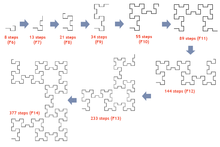
This curve is built iteratively by applying, to the Fibonacci word 0100101001001...etc., the Odd–Even Drawing rule:
For each digit at position k :
- if the digit is 0 : draw a segment in the current direction
- if the digit is 1 : draw a segment after a 90° angle turn:
- to the right if k is even
- to the left if k is odd
To a Fibonacci word of length (the nth Fibonacci number) is associated a curve made of segments. The curve displays three different aspects whether n is in the form 3k, 3k + 1, or 3k + 2.
Properties[1][2]
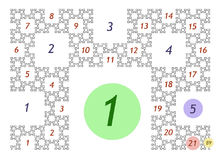
- The curve , contains segments, right angles and flat angles.
- The curve never self-intersects and does not contain double points. At the limit, it contains an infinity of points asymptotically close.
- The curve presents self-similarities at all scales. The reduction ratio is . This number, also called the silver ratio is present in a great number of properties listed below.
- The number of self-similarities at level n is a Fibonacci number \ −1. (more precisely : ).
- The curve encloses an infinity of square structures of decreasing sizes in a ratio . (see figure) The number of those square structures is a Fibonacci number.
- The curve can also be constructed by different ways (see gallery below):
- Iterated function system of 4 and 1 homothety of ratio and
- By joining together the curves and
- Lindermayer system
- By an iterated construction of 8 square patterns around each square pattern.
- By an iterated construction of octagons
- The Hausdorff dimension of the Fibonacci word fractal is , with , the golden ratio.
- Generalizing to an angle between 0 and , its Hausdorff dimension is , with .
- The Hausdorff dimension of its frontier is .
- Exchanging the roles of "0" and "1" in the Fibonacci word, or in the drawing rule yields a similar curve, but oriented 45°.
- From the Fibonacci word, one can define the « dense Fibonacci word», on an alphabet of 3 letters : 102210221102110211022102211021102110221022102211021... ((sequence A143667 in the OEIS)). The usage, on this word, of a more simple drawing rule, defines an infinite set of variants of the curve, among which :
- a «diagonal varaint»
- a «svastika variant»
- a «compact variant »
- It is conjectured that the Fibonacci word fractal appears for every sturmian word for which the slope, written in continued fraction expansion, ends with an infinite series of "1".
Gallery
-

Curve after iterations.
-

Self-similarities at different scales.
-

Dimensions.
-

Construction by juxtaposition (1)
-

Construction by juxtaposition (2)
-
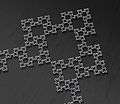
-

Construction by iterated suppression of square patterns.
-

Construction by iterated octagons.
-
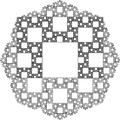
Construction by iterated collection of 8 square patterns around each square pattern.
-

With a 60° angle.
-

Inversion of "0" and "1".
-

Variants generated from the dense Fibonacci word.
-
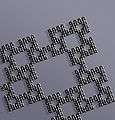
The "compact variant"
-

The "svastika variant"
-

The "diagonal variant"
-

The "pi/8 variant"
-
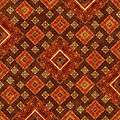
Artist creation (Samuel Monnier).
The Fibonacci tile
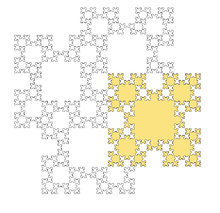
The juxtaposition of four curves allows the construction of a closed curve enclosing a surface whose area is not null. This curve is called a "Fibonacci Tile".
- The Fibonacci tile almost tiles the plane. The juxtaposition of 4 tiles (see illustration) leaves at the center a free square whose area tends to zero as k tends to infinity. At the limit, the infinite Fibonacci tile tiles the plane.
- If the tile is enclosed un a square of side 1, then its area tends to .
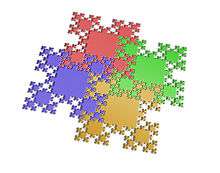
Fibonacci snowflake
The Fibonacci snowflake is a Fibonacci tile defined by:[3]
- if
- otherwise.
with and , "turn left" et "turn right", and ,
Several remarquable properties :[3] · :[4]
- It is the Fibonacci tile associated to the "diagonal variant" previously defined.
- It tiles the plane at any order.
- It tiles the plane by translation in two different ways.
- its perimeter, at order n, equals . is the nth Fibonacci number.
- its area, at order n, follows the successive indexes of odd row of the Pell sequence (defined by ).
References
- ↑ The Fibonacci word fractal
- ↑ "Hausdorff Dimension of Generalized Fibonacci Word Fractals".
- 1 2 Christoffel and Fibonacci tiles
- ↑ Fibonacci snowflakes
See also
External links
- "The Fibonacci word fractal", Alexis Monnerot-Dumaine, february 2009
- "Christoffel and Fibonacci tiles", A. Blondin-Massé, S. Labbé, S. Brlek, september 2009
- "Fibonacci snowfalkes", A. Blondin-Massé, S. Labbé, S. Brlek, M. Mendès-France 2010
- "Hausdorff dimension of generalized Fibonacci word fractals", Tyler Hoffman, Benjamin Steinhurst 2016